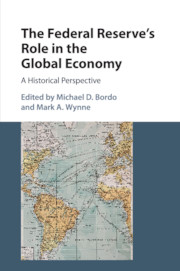Refine search
Actions for selected content:
26946 results in Economic history

The Economic History of China
- From Antiquity to the Nineteenth Century
-
- Published online:
- 05 March 2016
- Print publication:
- 07 March 2016

The Federal Reserve's Role in the Global Economy
- A Historical Perspective
-
- Published online:
- 05 March 2016
- Print publication:
- 01 April 2016
PHILIP II AGAINST THE CORTES AND THE CREDIT FREEZE OF 1575-1577*
-
- Journal:
- Revista de Historia Economica - Journal of Iberian and Latin American Economic History / Volume 34 / Issue 3 / December 2016
- Published online by Cambridge University Press:
- 04 March 2016, pp. 351-382
- Print publication:
- December 2016
-
- Article
- Export citation
RHE volume 34 issue 1 Cover and Back matter
-
- Journal:
- Revista de Historia Economica - Journal of Iberian and Latin American Economic History / Volume 34 / Issue 1 / March 2016
- Published online by Cambridge University Press:
- 02 March 2016, pp. b1-b2
- Print publication:
- March 2016
-
- Article
-
- You have access
- Export citation
RHE volume 34 issue 1 Cover and Front matter
-
- Journal:
- Revista de Historia Economica - Journal of Iberian and Latin American Economic History / Volume 34 / Issue 1 / March 2016
- Published online by Cambridge University Press:
- 02 March 2016, pp. f1-f4
- Print publication:
- March 2016
-
- Article
-
- You have access
- Export citation
NOTA DE LOS EDITORES
-
- Journal:
- Revista de Historia Economica - Journal of Iberian and Latin American Economic History / Volume 34 / Issue 1 / March 2016
- Published online by Cambridge University Press:
- 02 March 2016, pp. 6-10
- Print publication:
- March 2016
-
- Article
-
- You have access
- HTML
- Export citation
EDITORIAL NOTE
-
- Journal:
- Revista de Historia Economica - Journal of Iberian and Latin American Economic History / Volume 34 / Issue 1 / March 2016
- Published online by Cambridge University Press:
- 02 March 2016, pp. 3-5
- Print publication:
- March 2016
-
- Article
-
- You have access
- HTML
- Export citation
ENDOGENOUS PROCESSES OF COLONIAL SETTLEMENT. THE SUCCESS AND FAILURE OF EUROPEAN SETTLER FARMING IN SUB-SAHARAN AFRICA*
-
- Journal:
- Revista de Historia Economica - Journal of Iberian and Latin American Economic History / Volume 34 / Issue 2 / September 2016
- Published online by Cambridge University Press:
- 17 February 2016, pp. 237-265
- Print publication:
- September 2016
-
- Article
- Export citation
LA SEDA CHINA EN NUEVA ESPAÑA A PRINCIPIOS DEL SIGLO XVII. UNA MIRADA IMPERIAL EN EL MEMORIAL DE HORACIO LEVANTO*
-
- Journal:
- Revista de Historia Economica - Journal of Iberian and Latin American Economic History / Volume 35 / Issue 1 / March 2017
- Published online by Cambridge University Press:
- 17 February 2016, pp. 147-171
- Print publication:
- March 2017
-
- Article
-
- You have access
- HTML
- Export citation
Acknowledgements
-
- Book:
- The 'Conspiracy' of Free Trade
- Published online:
- 05 February 2016
- Print publication:
- 09 February 2016, pp xii-xiii
-
- Chapter
- Export citation
Index
-
- Book:
- The 'Conspiracy' of Free Trade
- Published online:
- 05 February 2016
- Print publication:
- 09 February 2016, pp 282-295
-
- Chapter
- Export citation
2 - “The most successful lie in history”
-
- Book:
- The 'Conspiracy' of Free Trade
- Published online:
- 05 February 2016
- Print publication:
- 09 February 2016, pp 33-55
-
- Chapter
- Export citation
5 - The Great Debate
-
- Book:
- The 'Conspiracy' of Free Trade
- Published online:
- 05 February 2016
- Print publication:
- 09 February 2016, pp 116-149
-
- Chapter
- Export citation
Bibliography
-
- Book:
- The 'Conspiracy' of Free Trade
- Published online:
- 05 February 2016
- Print publication:
- 09 February 2016, pp 280-281
-
- Chapter
- Export citation
9 - Republican rapprochement
-
- Book:
- The 'Conspiracy' of Free Trade
- Published online:
- 05 February 2016
- Print publication:
- 09 February 2016, pp 237-266
-
- Chapter
- Export citation
8 - Free trade in retreat
-
- Book:
- The 'Conspiracy' of Free Trade
- Published online:
- 05 February 2016
- Print publication:
- 09 February 2016, pp 206-236
-
- Chapter
- Export citation
6 - The cosmopolitan demand for North American commercial union, 1885–1889
-
- Book:
- The 'Conspiracy' of Free Trade
- Published online:
- 05 February 2016
- Print publication:
- 09 February 2016, pp 150-171
-
- Chapter
- Export citation
Preface
-
- Book:
- The 'Conspiracy' of Free Trade
- Published online:
- 05 February 2016
- Print publication:
- 09 February 2016, pp ix-xi
-
- Chapter
- Export citation
1 - Globalizing ideologies
-
- Book:
- The 'Conspiracy' of Free Trade
- Published online:
- 05 February 2016
- Print publication:
- 09 February 2016, pp 1-32
-
- Chapter
-
- You have access
- HTML
- Export citation
Contents
-
- Book:
- The 'Conspiracy' of Free Trade
- Published online:
- 05 February 2016
- Print publication:
- 09 February 2016, pp v-vi
-
- Chapter
- Export citation
